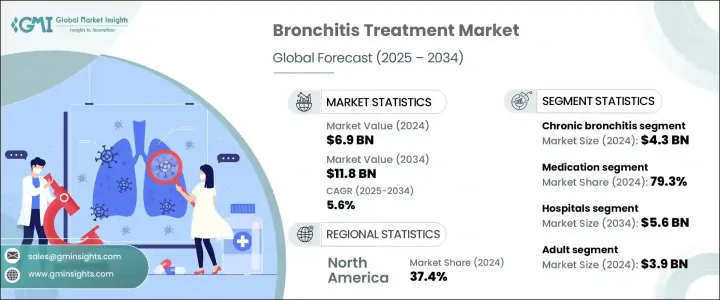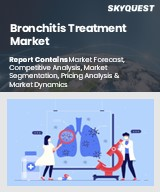
|
시장보고서
상품코드
1766210
기관지염 치료 시장 기회, 성장 촉진요인, 산업 동향 분석, 예측(2025-2034년)Bronchitis Treatment Market Opportunity, Growth Drivers, Industry Trend Analysis, and Forecast 2025 - 2034 |
||||||
세계의 기관지염 치료 시장 규모는 2024년에 69억 달러에 달했고, CAGR 5.6%를 나타내 2034년에는 118억 달러에 이를 것으로 예측됩니다.
이 성장의 원동력은 주로 흡연, 환경 오염 물질에 노출, 직업 위험, 바이러스 감염의 반복으로 인한 호흡기 질환의 부담 증가입니다. 바이러스와 관련되어 있지만, 특히 추운 시기에 빈도가 높아지고 있습니다. 이러한 호흡기 질환 증가는 효과적인 기관지염 치료제에 대한 수요를 끌어 올려 세계 시장 실적의 확대와 치료 방법의 혁신으로 이어지고 있습니다.

세계 인구의 고령화는 기관지염 관련 약제와 치료법 수요를 크게 밀어 올리고 있습니다. 기관지염은 기관지의 염증으로 정의되며, 통상 기도의 염증을 완화시키고, 점액을 느슨하게 하고, 기침을 진진시키고, 호흡 능력을 개선함으로써 치료됩니다.
| 시장 범위 | |
|---|---|
| 시작 연도 | 2024년 |
| 예측 연도 | 2025-2034년 |
| 시작 금액 | 69억 달러 |
| 예측 금액 | 118억 달러 |
| CAGR | 5.6% |
2024년 만성 기관지염 부문은 43억 달러를 창출했습니다. 이 부문은 지속적인 장기적 성질로 인해 일관된 의학적 감독과 복잡한 치료 전략이 필요하며 성장을 계속합니다. 만성 기관지염과 같은 급성 기관지염 뿐만 아니라 지속적인 관리가 필요하며 만성폐쇄성 폐질환(COPD) 등의 질환과 중복되는 경우가 많아 지속적인 치료의 필요성이 더욱 높아지고 있습니다.
약물 치료 분야는 2024년에 79.3%의 압도적인 점유율을 차지했습니다. 이 약물은 급성 및 만성 기관지염 증상의 관리에 필수적입니다. 일반적으로 불쾌한 증상인 기도에서 여분의 점액의 배출을 돕기 위해 자주 처방됩니다. 이 분야는 증상 컨트롤에 있어서의 유효성이 실증되고 있는 것에 더해, 장시간 작용형 제제나 흡입식 제제 등, 환자의 복약 준수와 치료 성적을 향상시키는 약물전달·시스템의 기술 혁신.
2024년 미국의 기관지염 치료 시장 규모는 23억 달러로 평가되었고, 세계 성장의 주요 요인이 되고 있습니다. 호흡기 질환에 대한 감수성 증가는 성장의 주요 원인입니다. 밀집한 도시에서는 알레르겐이나 오염에 노출되는 사람이 늘어나고 있으며, 기관지염의 진단수는 증가의 길을 따라가고 있습니다. 기타 혜택에는 강력한 건강 관리 인프라, 보험 적용 범위 확대, 공중 보건 캠페인 강화 등이 포함되어 있으며, 이들 모두가 치료에 대한 액세스를 향상시키고 있습니다. 확립된 의약품 존재와 지속적인 제품 개척은 세계의 기관지염 치료 시장에서 미국 시장의 입지를 더욱 견고하게 만들고 있습니다.
세계의 기관지염 치료 시장 주요 기업으로는 Sunovion Pharma, Glenmark, Lupin, 3M Pharmaceuticals, Pfizer, Sanofi, Reckitt Benckiser, Dr. Reddy's Laboratories, Boehringer Ingelheim, Johnson & Johnson, Teva Kharmaceutica Pharma, Macleods Pharmaceuticals, Merck 등이 있습니다. 기관지염 치료 시장에서 사업을 전개하는 기업은 시장에서의 존재감을 높이기 위해 다방면의 접근법을 채택하고 있습니다. 주요 기업은 환자의 결과와 규정 준수를 개선하는 서방형 제제, 흡입 가능한 치료제, 약물 제제를 개발하기 위해 연구 개발에 많은 투자를 하고 있습니다. 전략적 파트너십 및 라이선싱 계약은 제품 파이프라인과 지리적 범위를 확대하기 위해 진행되고 있습니다. 노인 인구 증가를 배경으로 많은 기업들이 만성 기관지염 치료제에 대한 주력을 강화하고 있습니다.
목차
제1장 조사 방법과 범위
제2장 주요 요약
제3장 업계 인사이트
- 생태계 분석
- 공급자의 상황
- 각 단계에서의 부가가치
- 밸류체인에 영향을 주는 요인
- 업계에 미치는 영향요인
- 성장 촉진요인
- 의료에의 액세스의 향상
- 호흡기 질환의 이환율 증가
- 의약품 개발과 치료 선택의 진보
- 업계의 잠재적 위험 및 과제
- 약물 규정 준수 문제
- 대체의료의 이용가능성
- 시장 기회
- 대기오염과 흡연률 증가
- 시판약의 이용가능성의 확대와 자기치료 증가 경향
- 성장 촉진요인
- 성장 가능성 분석
- 규제 상황
- 북미
- 유럽
- 아시아태평양
- 향후 시장 동향
- 파이프라인 분석
- 가격 분석
- 소비자 행동 분석
- Porter's Five Forces 분석
- PESTEL 분석
제4장 경쟁 구도
- 서론
- 기업 매트릭스 분석
- 기업의 시장 점유율 분석
- 주요 시장 기업의 경쟁 분석
- 경쟁 포지셔닝 매트릭스
- 주요 발전
- 합병과 인수
- 파트너십 및 협업
- 신제품 발매
제5장 시장 추계·예측 : 질환 유형별(2021-2034년)
- 주요 동향
- 급성 기관지염
- 만성 기관지염
제6장 시장 추계·예측 : 치료별(2021-2034년)
- 주요 동향
- 약
- 약제 유형별
- 기침 억제제
- 기관지 확장제
- 점액 활성제
- 기타
- 유형별
- 처방전
- 시판약(OTC)
- 투여 경로별
- 경구
- 비강
- 주사제
- 약제 유형별
- 산소요법
제7장 시장 추계·예측 : 연령별(2021-2034년)
- 주요 동향
- 소아
- 성인
- 노인
제8장 시장 추계·예측 : 최종 용도별(2021-2034년)
- 주요 동향
- 병원
- 클리닉
- 재택 케어
- 기타 최종 용도
제9장 시장 추계·예측 : 지역별(2021-2034년)
- 주요 동향
- 북미
- 미국
- 캐나다
- 유럽
- 독일
- 영국
- 프랑스
- 스페인
- 이탈리아
- 네덜란드
- 아시아태평양
- 중국
- 일본
- 인도
- 호주
- 한국
- 라틴아메리카
- 브라질
- 멕시코
- 아르헨티나
- 중동 및 아프리카
- 남아프리카
- 사우디아라비아
- 아랍에미리트(UAE)
제10장 기업 프로파일
- 3M pharmaceuticals
- Aurobindo Pharma
- Boehringer Ingelheim
- Dr. Reddy's Laboratories
- GlaxoSmithKline
- Glenmark
- Johnson &Johnson
- Lupin
- Merck
- Macleods Pharmaceuticals
- Pfizer
- Reckitt Benckiser
- Sunovion Pharma
- Sanofi
- Teva Pharmaceuticals
The Global Bronchitis Treatment Market was valued at USD 6.9 billion in 2024 and is estimated to grow at a CAGR of 5.6% to reach USD 11.8 billion by 2034. This growth is being driven by an increasing burden of respiratory conditions, mainly due to smoking, exposure to environmental pollutants, occupational hazards, and recurring viral infections. Acute bronchitis, typically linked with seasonal viruses like influenza and RSV, is becoming more frequent, especially during colder months. This rise in respiratory illnesses is pushing up demand for effective bronchitis therapies, leading to stronger market performance and innovation in treatment modalities worldwide.

An aging global population is significantly boosting demand for bronchitis-related medications and therapies. Older adults are more likely to develop chronic respiratory conditions because of weakened immunity and diminished lung function. As the demographic aged 65 and over continues to expand, so does the consumption of bronchodilators, anti-inflammatory drugs, and other inhaled treatments. Bronchitis, defined as inflammation of the bronchial tubes, is typically treated by relieving airway inflammation, loosening mucus, calming cough, and improving breathing capacity. Most patients require drug-based therapies like bronchodilators, expectorants, and anti-inflammatories. In more severe cases, oxygen therapy is introduced to help patients manage their breathing effectively.
| Market Scope | |
|---|---|
| Start Year | 2024 |
| Forecast Year | 2025-2034 |
| Start Value | $6.9 Billion |
| Forecast Value | $11.8 Billion |
| CAGR | 5.6% |
In 2024, chronic bronchitis segment generated USD 4.3 billion. This segment continues to grow due to the persistent and long-term nature of chronic bronchitis, which requires consistent medical supervision and complex therapeutic strategies. Unlike the short-lived nature of acute bronchitis, chronic bronchitis demands ongoing management and frequently overlaps with conditions such as chronic obstructive pulmonary disease (COPD), further escalating the need for continuous care. As older populations rise globally, cases of long-term respiratory disease are also on the rise, driving additional demand for chronic bronchitis treatment.
The medication segment held a commanding 79.3% share in 2024. This category includes widely used drugs such as bronchodilators, cough suppressants, mucoactive agents, and other therapeutic drugs. These treatments are essential for managing both acute and chronic bronchitis symptoms. Cough suppressants and expectorants are prescribed frequently to manage persistent coughing and help expel excess mucus from the airways-two of the most common and discomforting symptoms for bronchitis patients. The segment continues to thrive due to its proven effectiveness in symptom control and ongoing innovations in drug delivery systems, including long-acting formulations and inhalable formats, which improve patient adherence and therapeutic outcomes.
United States Bronchitis Treatment Market reached USD 2.3 billion in 2024, making it a key contributor to global growth. The increasing susceptibility of the population to respiratory illnesses is a primary growth driver. With more people exposed to allergens and pollution in dense urban areas, the number of bronchitis diagnoses continues to climb. Additionally, the country benefits from strong healthcare infrastructure, wider insurance coverage, and enhanced public health campaigns, all of which improve access to treatment. A well-established pharmaceutical presence, along with continual product development, is further solidifying the US market's position in the global bronchitis treatment landscape.
Major players in the Global Bronchitis Treatment Market include Sunovion Pharma, Glenmark, Lupin, 3M Pharmaceuticals, Pfizer, Sanofi, Reckitt Benckiser, Dr. Reddy's Laboratories, Boehringer Ingelheim, Johnson & Johnson, Teva Pharmaceuticals, GlaxoSmithKline, Aurobindo Pharma, Macleods Pharmaceuticals, and Merck. Companies operating in the bronchitis treatment market are adopting a multi-pronged approach to enhance market presence. Key players are heavily investing in R&D to develop extended-release formulations, inhalable therapies, and drug combinations that improve patient outcomes and compliance. Strategic partnerships and licensing agreements are being pursued to expand product pipelines and geographic reach. Many firms are increasing their focus on chronic bronchitis solutions, given the growing elderly population.
Table of Contents
Chapter 1 Methodology and Scope
- 1.1 Market scope and definitions
- 1.2 Research design
- 1.2.1 Research approach
- 1.2.2 Data collection methods
- 1.3 Data mining sources
- 1.3.1 Global
- 1.3.2 Regional/Country
- 1.4 Base estimates and calculations
- 1.4.1 Base year calculation
- 1.4.2 Key trends for market estimation
- 1.5 Primary research and validation
- 1.5.1 Primary sources
- 1.6 Forecast model
- 1.7 Research assumptions and limitations
Chapter 2 Executive Summary
- 2.1 Industry 3600 synopsis
- 2.2 Key market trends
- 2.2.1 Regional
- 2.2.2 Disease type
- 2.2.3 Treatment
- 2.2.4 Age group
- 2.2.5 End use
- 2.3 CXO perspectives: Strategic imperatives
- 2.3.1 Key decision points for industry executives
- 2.3.2 Critical success factors for market players
- 2.4 Future outlook and strategic recommendations
Chapter 3 Industry Insights
- 3.1 Industry ecosystem analysis
- 3.1.1 Supplier landscape
- 3.1.2 Value addition at each stage
- 3.1.3 Factors affecting the value chain
- 3.2 Industry impact forces
- 3.2.1 Growth drivers
- 3.2.1.1 Increased health access
- 3.2.1.2 Increasing prevalence of respiratory diseases
- 3.2.1.3 Advancement in drug developments and treatment options
- 3.2.2 Industry pitfalls and challenges
- 3.2.2.1 Drug compliance issues
- 3.2.2.2 Availability of alternative medicines
- 3.2.3 Market opportunities
- 3.2.3.1 Increase in air pollution and smoking rates
- 3.2.3.2 Expanding over-the-counter availability and increasing trend of self-medications
- 3.2.1 Growth drivers
- 3.3 Growth potential analysis
- 3.4 Regulatory landscape
- 3.4.1 North America
- 3.4.2 Europe
- 3.4.3 Asia Pacific
- 3.5 Future market trends
- 3.6 Pipeline analysis
- 3.7 Pricing analysis
- 3.8 Consumer behaviour analysis
- 3.9 Porter's analysis
- 3.10 PESTEL analysis
Chapter 4 Competitive Landscape, 2024
- 4.1 Introduction
- 4.2 Company matrix analysis
- 4.3 Company market share analysis
- 4.4 Competitive analysis of major market players
- 4.5 Competitive positioning matrix
- 4.6 Key developments
- 4.6.1 Mergers and acquisitions
- 4.6.2 Partnership and collaborations
- 4.6.3 New product launches
Chapter 5 Market Estimates and Forecast, By Disease Type, 2021 - 2034 ($ Mn)
- 5.1 Key trends
- 5.2 Acute bronchitis
- 5.3 Chronic bronchitis
Chapter 6 Market Estimates and Forecast, By Treatment, 2021 - 2034 ($ Mn)
- 6.1 Key trends
- 6.2 Medication
- 6.2.1 By drug type
- 6.2.1.1 Cough suppressants
- 6.2.1.2 Bronchodilators
- 6.2.1.3 Mucoactive agents
- 6.2.1.4 Other drugs
- 6.2.2 By type
- 6.2.2.1 Prescription
- 6.2.2.2 Over-the-counter (OTC)
- 6.2.3 By route of administration
- 6.2.3.1 Oral
- 6.2.3.2 Nasal
- 6.2.3.3 Injectable
- 6.2.1 By drug type
- 6.3 Oxygen therapy
Chapter 7 Market Estimates and Forecast, By Age Group, 2021 - 2034 ($ Mn)
- 7.1 Key trends
- 7.2 Pediatric
- 7.3 Adult
- 7.4 Geriatric
Chapter 8 Market Estimates and Forecast, By End Use, 2021 - 2034 ($ Mn)
- 8.1 Key trends
- 8.2 Hospitals
- 8.3 Clinics
- 8.4 Homecare settings
- 8.5 Other end use
Chapter 9 Market Estimates and Forecast, By Region, 2021 - 2034 ($ Mn)
- 9.1 Key trends
- 9.2 North America
- 9.2.1 U.S.
- 9.2.2 Canada
- 9.3 Europe
- 9.3.1 Germany
- 9.3.2 UK
- 9.3.3 France
- 9.3.4 Spain
- 9.3.5 Italy
- 9.3.6 Netherlands
- 9.4 Asia Pacific
- 9.4.1 China
- 9.4.2 Japan
- 9.4.3 India
- 9.4.4 Australia
- 9.4.5 South Korea
- 9.5 Latin America
- 9.5.1 Brazil
- 9.5.2 Mexico
- 9.5.3 Argentina
- 9.6 Middle East and Africa
- 9.6.1 South Africa
- 9.6.2 Saudi Arabia
- 9.6.3 UAE
Chapter 10 Company Profiles
- 10.1 3M pharmaceuticals
- 10.2 Aurobindo Pharma
- 10.3 Boehringer Ingelheim
- 10.4 Dr. Reddy’s Laboratories
- 10.5 GlaxoSmithKline
- 10.6 Glenmark
- 10.7 Johnson & Johnson
- 10.8 Lupin
- 10.9 Merck
- 10.10 Macleods Pharmaceuticals
- 10.11 Pfizer
- 10.12 Reckitt Benckiser
- 10.13 Sunovion Pharma
- 10.14 Sanofi
- 10.15 Teva Pharmaceuticals



















